As a part of the Operations & Algebraic Thinking standards, 1st grade students are expected to add and subtract within 20, building fluency within 10 using a variety of strategies. (The fluency benchmark for kindergarten is 5 and for 2nd grade it is 20.) The “variety of strategies” includes, but is not limited to, making a ten, decomposing a number to a ten (i.e. making 10 to subtract), relating addition and subtraction, and equivalent sums. As teachers we offer, highlight, and celebrate different strategies so students have a “toolbox” to choose from when solving a problem. Students will have individual preferences. Different situations lend themselves to the use of different strategies. This is okay and expected.
In 1st grade 10 becomes a benchmark number, which supports addition and subtraction as a mental process. Making 10 to Subtract is an important skill for our primary learners. Initially, though, this can be a tough skill. (Snag resources for your classroom here or the Add/Subtract Bundle here.)
Building Conceptual Understanding of Making 10 to Subtract
As we are guiding students to 10, it must be a hands-on process. Students must have hands-on opportunities to break apart numbers, redistribute their placement on ten frames, and create new equations. Students should be repeatedly building, moving, and creating equations with counters and ten frames.
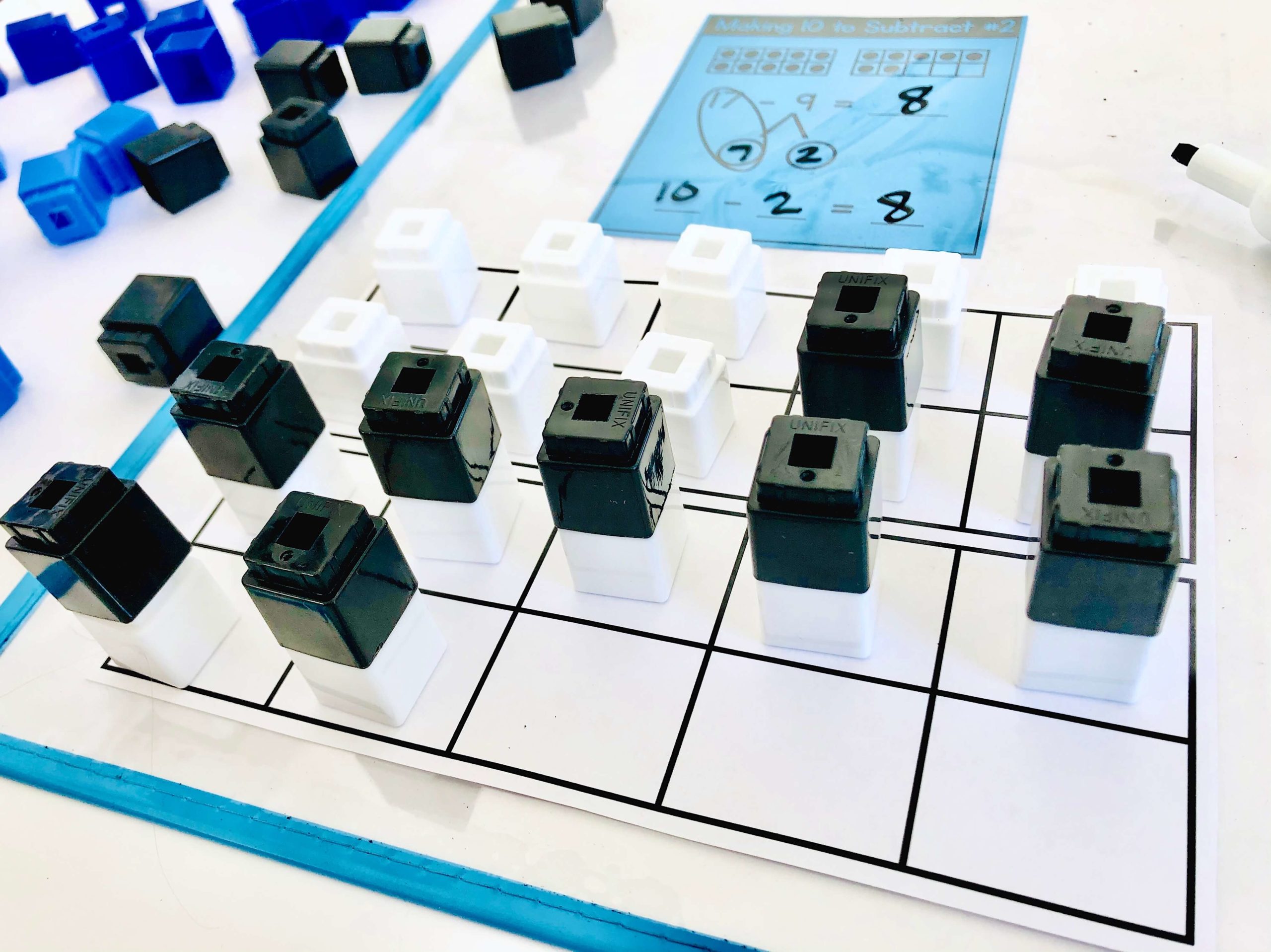
Then, we move students to the semi-concrete, drawing and illustrating the process.
Finally, students use numbers and number bonds to show their thinking in the abstract.
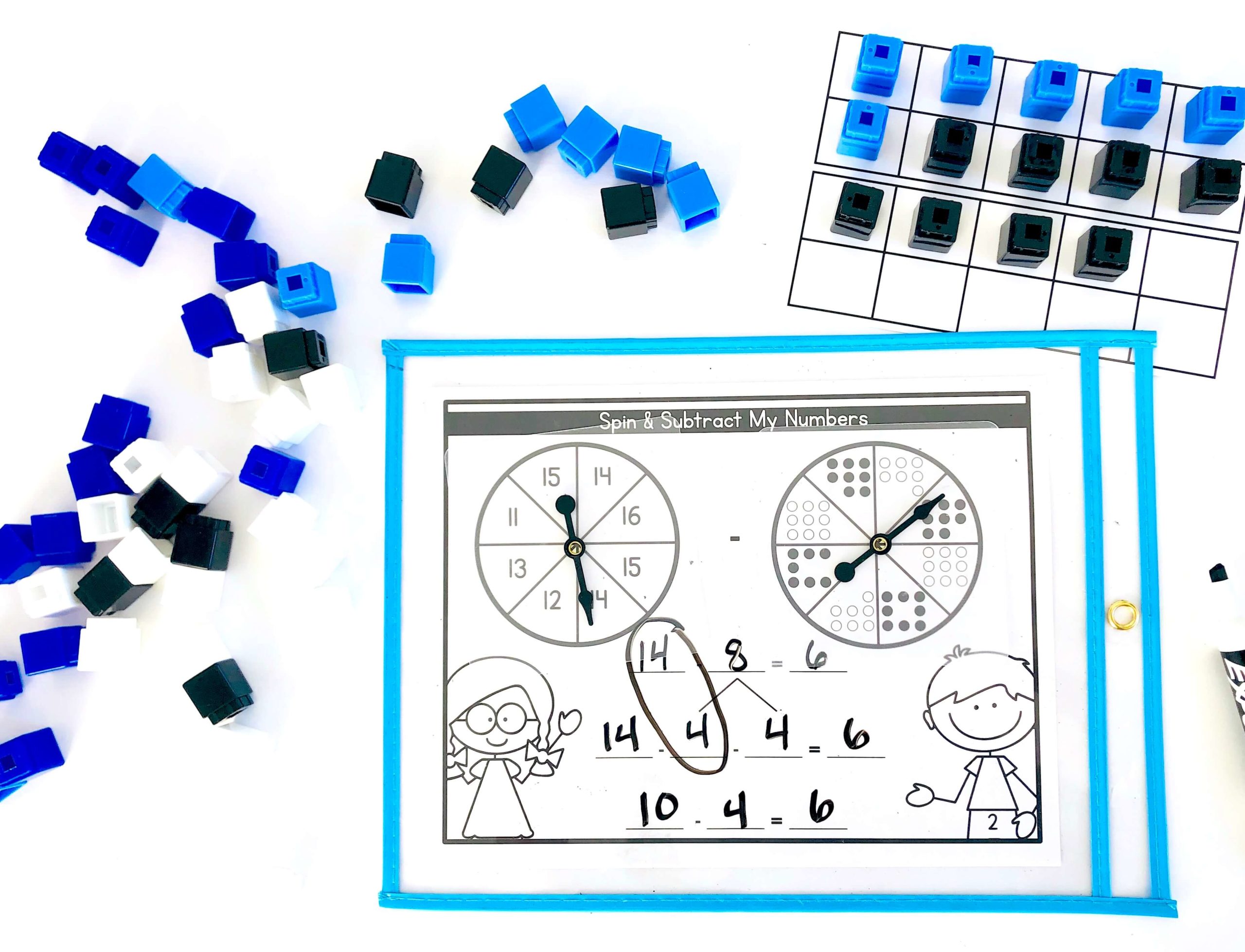
If students struggle within this CSA continuum we back up. When semi-concrete understanding is a struggle, then return to the semi-concrete. Should we progress to semi-concrete and realize it’s a mess, we take it back to different concrete experiences. Even when students can “do the numbers” it’s important to ensure they really have a conceptual understanding. This understanding is critical to true mastery of Making 10 to Subtract.
Practice with Making 10 to Subtract
For many students (myself include) 10 is not as natural of a benchmark for subtraction as it is addition. Therefore, it may require more concrete experiences and more play! Long-term we don’t want to force students into using this strategy, but we do want them to be proficient enough to be able to employ it when a problem or situation demands it.
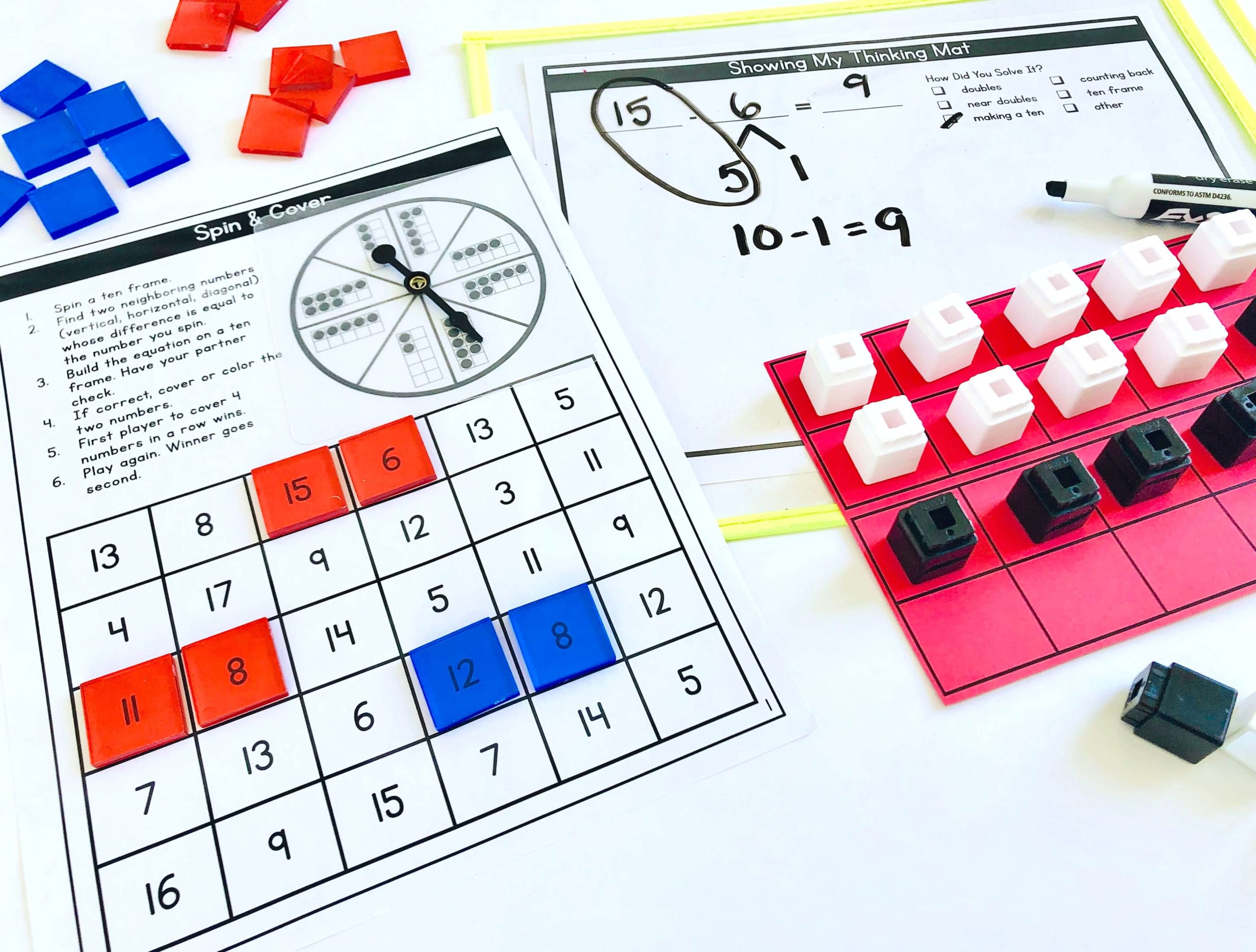
Using numbers carefully crafted to support the use of Make 10 to Subtract, students roll an equation. Working in the semi-concrete, students then draw their initial subtrahend on the ten frame. Then, students cross-out/subtract the second smaller subtrahend. Students then write the equations that match their ten frames. This is a perfect game to teach at Teacher Table and then, introduce later as a math center.
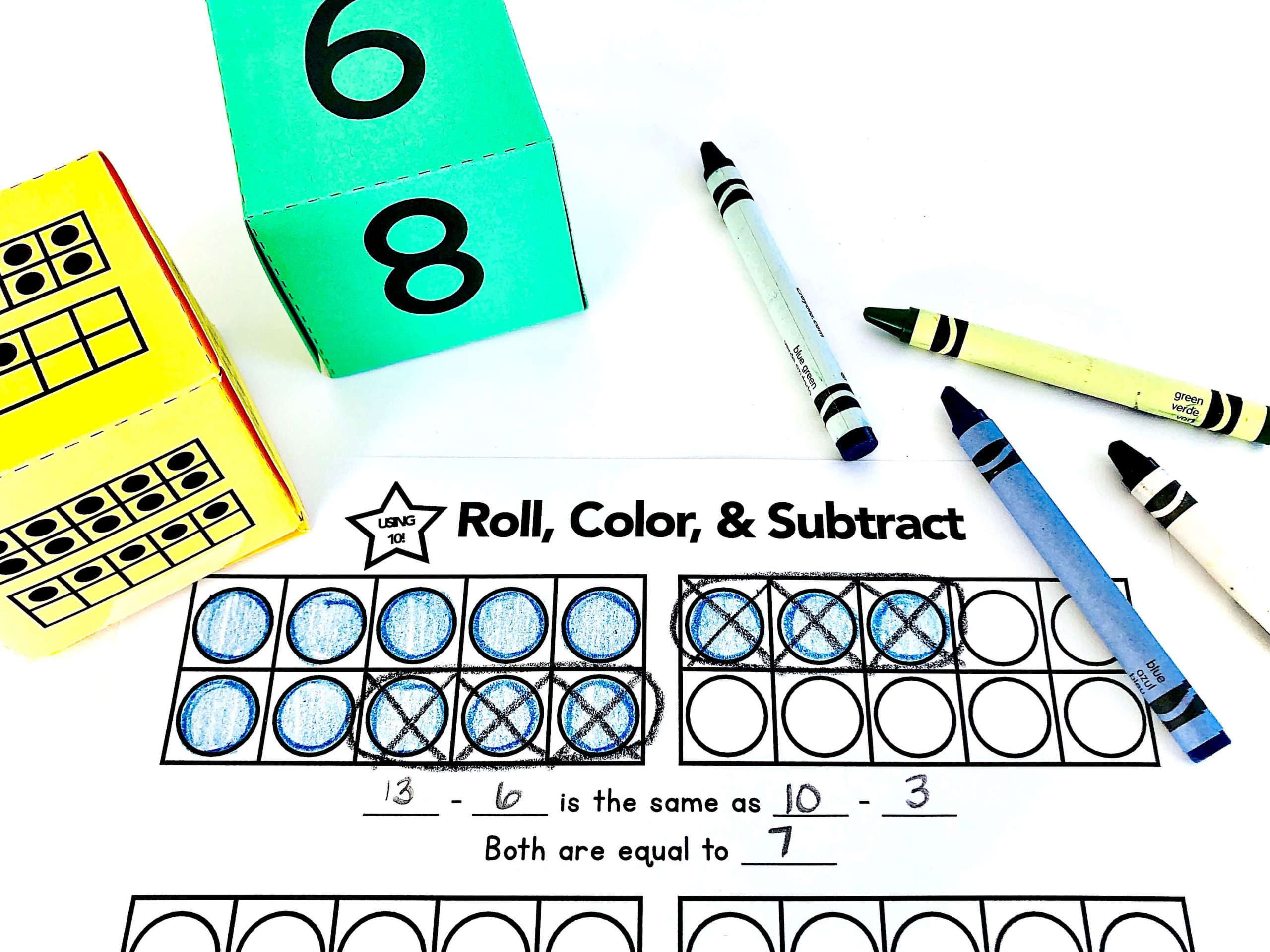
Math Journals
Not only do students have opportunities to build conceptual understanding with hands-on math experiences, they also need scaffold opportunities to talk math (verbally and written)!
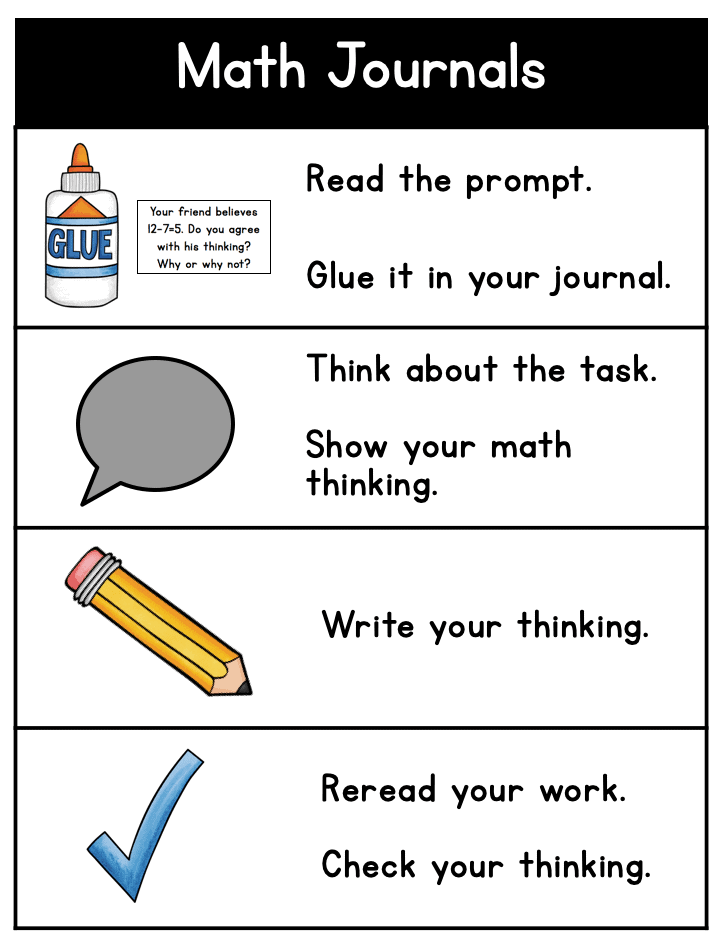
Math Journals give students the opportunity to show and explain their math thinking. If students have never been asked to explain their thinking (not just the process) this can be a daunting task. The less experience students have with writing about math, the more teacher modeling and scaffolding they may need. Modeling your expectations for showing work, math thinking, use of vocabulary, and readability will be a vital part of making math journals a worthwhile venture.
After laying the expectations and groundwork, I often transition math journals to small group, where students have more opportunities explain their thinking verbally. Then, building on the oral language, students write down their thoughts.
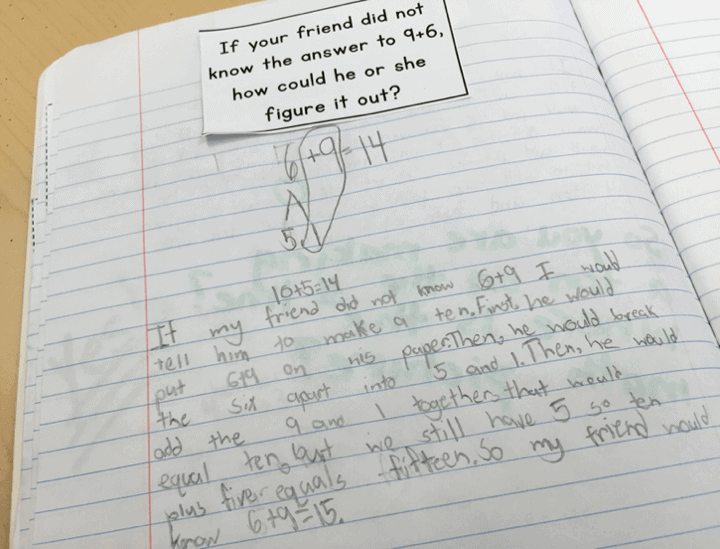
Once modeled in whole and small group, some students may require more support through sentence stems and frames. Frames are the highest level of writing support (outside of dictating) and should be strategically used. A frame removes a significant amount of the cognitive lift from a task. Eventually, it is the goal that these prompts become independent activities. (Scaffold shouldn’t stay in place forever.)
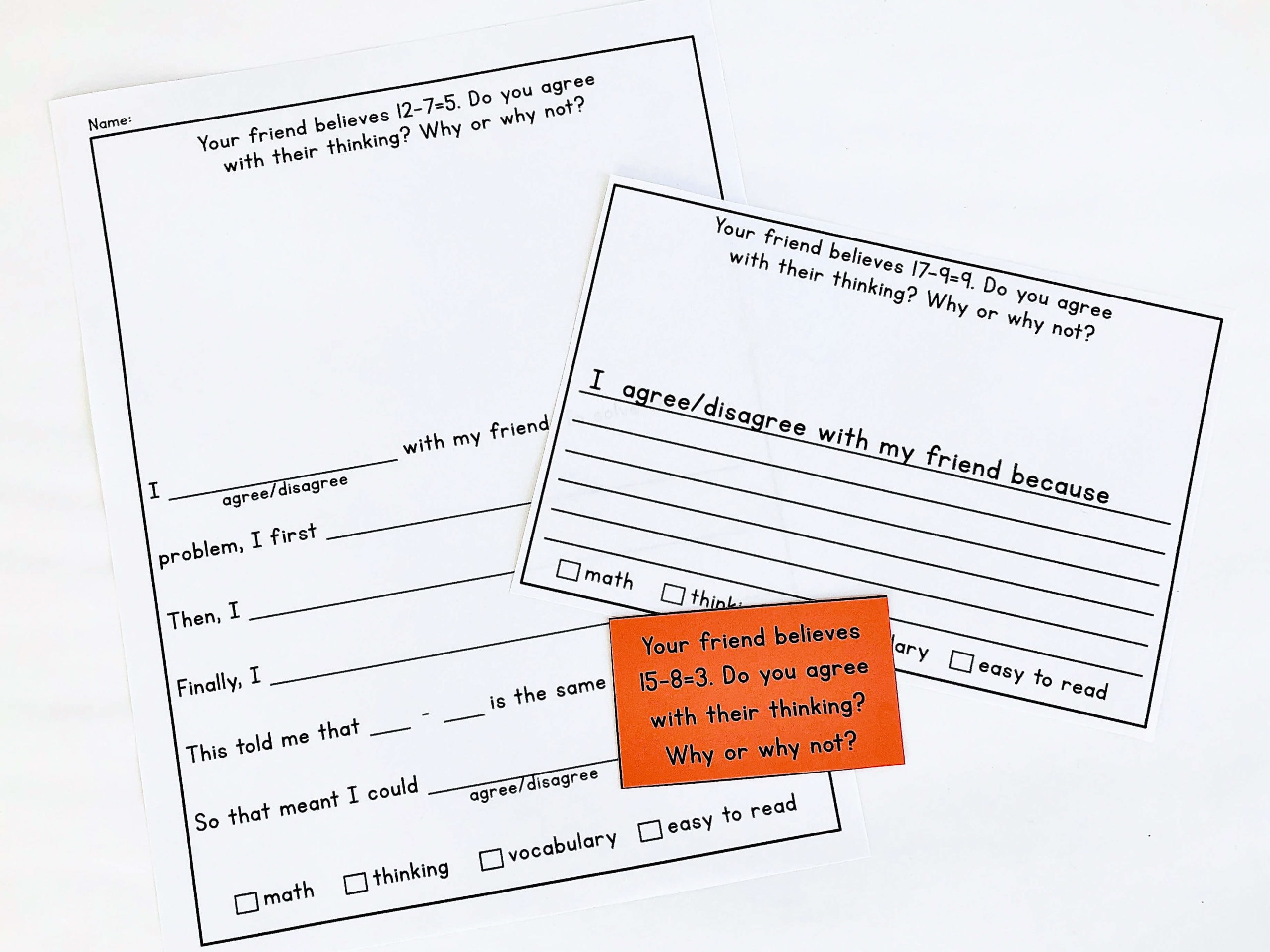
Wrapping It Up
We want our students to be confident in deciding when and if to use the Making 10 to Subtract strategy, so that means students will need intentional daily math instruction through a mixture of whole-group, small group (through guided math or RTI groups), as well as, opportunities to practice though games and centers.
So, as you venture into this Operations & Algebraic Thinking standard, I’m cheering for you and for your students. You all have got this.
Snag the discounted Making 10 To Add & Subtract bundle here, the Making 10 to Subtract resource here, and the Making 10 to Add resource here. Read more about Making 10 to Add on the blog here.
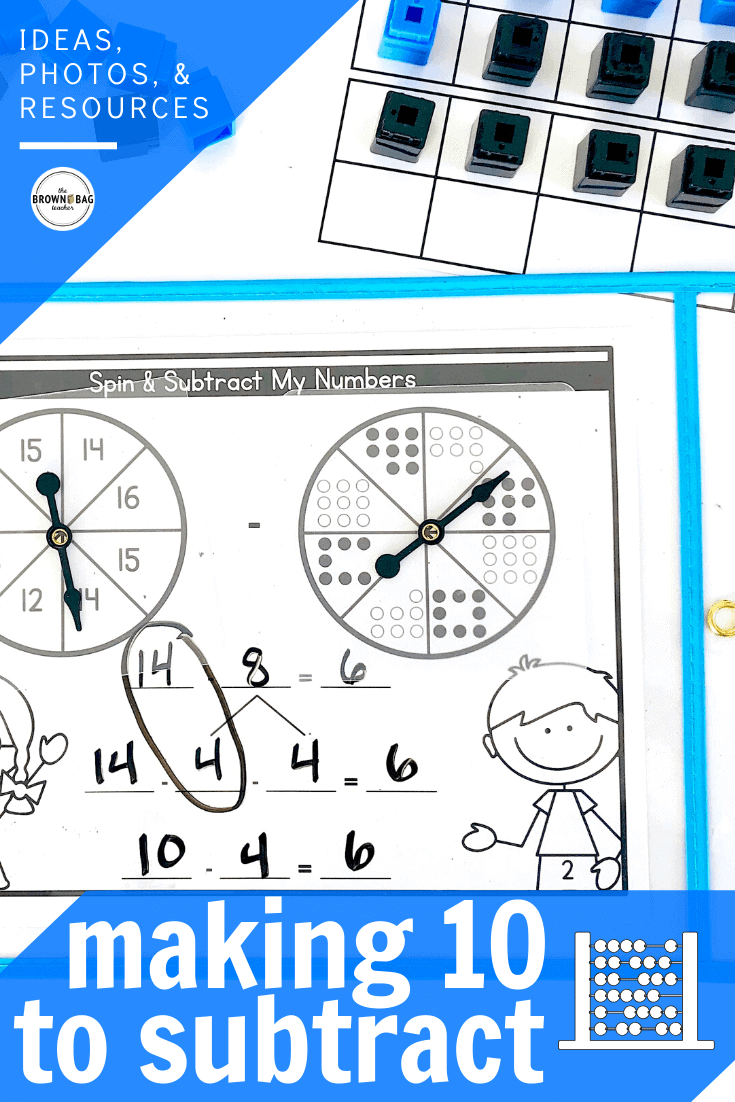
Get Free Teaching Resources!
Join me for weekly classroom updates and free resources that are just-right for your guided math classroom!





I need help with my child she a bright little girl but her teachers are treating her as if she dummy and disrespecting her education no giving her a chance at a decent education..
Los casinos en línea me parecían seguros, así que encontré este sitio con toda la información que necesitaba. https://xn--casinosonlineespaa-30b.org/seguros
Thanks for sharing such a valuable post. Please keep us updated for future posts.
Thanks for sharing such a valuable post. Please keep us updated for future posts.
EXPERT IN RECOVERY
I’m short of words for the amazing profit you helped me earn in just a week with binary options strategy am so sorry I doubted at the beginning, I invested $2000 and earn $13,500 in just one week, and kept on investing more, today I am financially successful, you can contact him.
Instagram : hacker judas
via Email: hackerjudas9@gmail.com
How to get money back from Crypto scammers …….
The threat of hackers looms large, with devastating consequences for individuals and businesses alike. The rise of cryptocurrencies, such as bitcoin, has attracted the attention of cybercriminals seeking to exploit vulnerabilities and steal valuable assets. The alarming increase in bitcoin theft has highlighted the urgent need for robust Folkwin recovery solutions that can counter these attacks and reclaim lost funds. Hackers looking to take advantage of Bitcoin’s weaknesses are becoming a greater threat as the cryptocurrency’s value and adoption rise. The Folkwin expert recovery is a new and sophisticated method that has gradually eclipsed the traditional approaches used by hackers to target Bitcoin owners. The world of cryptocurrency has witnessed a surge in popularity, with Bitcoin emerging as the leading digital currency. However, as more individuals venture into the realm of Bitcoin ownership, the risk of hacking and cyber attacks has also increased. Hackers have employed various techniques to target Bitcoin owners, but a new method called Folkwin expert recovery is now surpassing traditional tactics, adding a twist to the ever-evolving landscape of Bitcoin hacking. Traditional methods have long been used by hackers to take advantage of Bitcoin owners and access their digital riches. Phishing attacks are a common tactic in which people are fooled into disclosing personal information about themselves. Furthermore, Bitcoin wallets have been the subject of ransomware and malware assaults that take control and demand a ransom in exchange. Another strategy tries to crack the complex private keys that safeguard Bitcoin holdings using dictionary and brute force attacks. Even though there are many benefits associated with the Folkwin expert recovery procedure, it is important to take into account its drawbacks and difficulties. To successfully combat sophisticated hacking techniques, putting this strategy into practice might need a significant infrastructure and resource investment and Folkwin expert recovery has got this all. Contact them throught Email: Folkwinexpertrecovery (at) tech-cementer (dot) com or Telegram: @folkwinexpertrecovery here for assistance.
Regards,
Mis Mary Anne Noonan …
I was convinced by someone I met online to invest in crypto.They had access to a team of analysts that gave good signals on when BTC would go up. First I tried with a small amount just to confirm and was able to withdraw a couple of times. This indicated the signals I was being given were growing. I decided to put it all in including college money. That is when everything went bad because I tried to reach the person and he had blocked all his contacts I tried everything until I was referred to George Wizard. They truly helped me to recover everything at an affordable fee and I was elated.If you in need try them on EMAIL: georgewizardrecoveryhome@gmail.com WHATSAPP +1 (908) 768-4663
After recognizing that an outflow of $300,000 worth of Bitcoin had occurred without my approval from my wallet, I understood that my wallet had been hijacked. I was very interested in discovering what had happened and getting my Bitcoin back at any length it will take. The 12-word seed phrase data that came from the wallet was stolen after they gained access to my email, but I still don’t know how it all transpired in such a hurry because all I did was click a link from a purchase order confirmation. To obtain some guidance on how I can get my stolen Bitcoin back, I promptly contacted a coworker who is knowledgeable about cryptocurrencies. With luck on my side, he was able to give me the contact to Experienced Hackers Services which is: (experiencedhackers @gmail. com). I couldn’t regain my crypto till I contacted Experienced Hackers Services. After I explained everything to Experienced Hackers Services, they were able to recover my crypto. At first, I didn’t believe this was even feasible or achievable because most of the articles I read while surfing the net for help on how to recover stolen Bitcoin mostly say that Bitcoin cannot be traced or recovered, but Experienced Hackers Services saved a poor widow. Nothing in the realm of hacking, in my opinion, is tough for Experienced Hackers Services..
Do you want to dive into the exciting world of gambling? Then best bookmakers companies is your choice! I’ve been playing them for some time now, and every time they surprise me. Do you like the variety of games? There’s everything from exciting slots with stunning graphics to tables with live dealers, where the excitement kicks in. And if you appreciate bonuses as much as I do, you’re in luck. From welcome gifts to regular promotions, you won’t be bored here.
Do you want to dive into the exciting world of gambling? Then best bookmakers companies is your choice! I’ve been playing them for some time now, and every time they surprise me. Do you like the variety of games? There’s everything from exciting slots with stunning graphics to tables with live dealers, where the excitement kicks in. And if you appreciate bonuses as much as I do, you’re in luck. From welcome gifts to regular promotions, you won’t be bored here.
Do you want to dive into the exciting world of gambling? Then best bookmakers companies is your choice! I’ve been playing them for some time now, and every time they surprise me. Do you like the variety of games? There’s everything from exciting slots with stunning graphics to tables with live dealers, where the excitement kicks in. And if you appreciate bonuses as much as I do, you’re in luck. From welcome gifts to regular promotions, you won’t be bored here.
IS IT POSSIBLE TO ACTUALLY GET BACK FUNDS LOST TO CRYPTOCURRENCY SCAM? ABSOLUTELY, YES. DO YOU DESIRE CREDIT REPAIR?(TRANSUNION, EQUIFAX, EXPERIAN). YOU MUST CONTACT THE RIGHT AGENCY TO ACHIEVE THIS.
Wild Hack is a financial regulator, private investigation and funds recovery body. We specialize in cases concerning ethical hacking, cryptocurrency, FAKE investment schemes and recovery scam. We are also experts in credit repair.
E-mail: wildhacker16 at g mail . c om
Stay Safe !
Have you lost hope of ever recovering your money from scam brokers? I have good news for you and yes it is 97% possible for you to recover your money through Experienced Hackers Services, I had lost over $128,000 to a fake broker and I lost hope of ever making profit through binary trading. After the loss, I had a long research on how to recover the lost funds, I came across Experienced Hacker Services, a Specialized Crypto Recovery Expert who helped Scam Victims recover their Lost Funds. After submitting my case the expert worked on my case and all my funds were recovered back. To anyone looking for a Recovery firm to Recover your lost Crypto contact.
Email: experiencedhackers@ gmail. com
Hello everyone, Waugh is my name and I want to joyfully share my personal encounter of how I was able to gain full access back to my cryptocurrency wallet and recover all the funds therein. For months, I couldn’t perform any succesful transactions from my Bitcoin wallet, always getting error messages, transaction incomplete and most annoying, unexplained deductions even when I had thousands of dollars on my balance. I shared so many emails and even phone calls with the customer care representative of the bitcoin wallet app I was using and all feedback I got never helped. I came across Daniel Meuli Web Recovery through an online review and decided to give it a try as I had no other options. I was greatly marvelled at their prompt and swift assistance from @ Danielmeuliweberecovery (@) email . come WhatsApp +39 351 201 3528 Or Telegram (@) Danielmeuli, as they were able to resolve all of my complains and helped me gain full access back to my wallet, recovered lost amount through deductions and further advise on how to secure my wallet. Their services was truly applaudable! I’m sharing this as my own way of assisting whoever that’s facing any cryptocurrency issues, as contacting only the right digital recovery firm can help.
I want to use this opportunity to demonstrate my formal admiration to Experienced Hackers Services, A reputable Bitcoin recovery cyber investigator, for their support in assisting me in recovering the money I lost to deception. I was victimized by an online trick artist who described themselves as an expert and accomplished trader in cryptocurrency. I invested over $350,000 in cryptocurrencies. I got to dedicate hours to hunting for a cryptocurrency recovery solution after the scam left me defenseless and conned me. I discovered Experienced Hackers Services to be the expert. After explaining my predicament to these experts, I just had to wait and all of my money was returned to my wallet in less than 4 hours. I want to thank Experienced Hackers Services for their fantastic help obtaining my money back. If you have sent your cryptocurrency to the incorrect wallet or misplaced it, you can contact Experienced Hackers Services via their Email: (experiencedhackers @gmail. com) immediately for a speedy return of your assets.
REAL AND LEGITIMATE CRYPTO RECOVERY EXPERT
I was actually fooled and scammed over ( $345,000 ) by someone I trusted with my funds through a transaction we did and I feel so disappointed and hurt knowing that someone can steal from you without remorse after trusting them, so I started searching for help legally to recover my stolen funds and came across a lot of Testimonials about ETHICREFINANCE Recovery Expert who helps in recovery lost funds, which I can tell has helped so many people who had contacted them regarding such issues and without a questionable doubt their funds was returned back to their wallet in a very short space of time, it took the expert 21 hours to help me recover my funds and the best part of it all was that the scammers was actually located and arrested by local authorities in his region which was very relieving. Hope this helps as many people who have lost their hard earn money to scammers out of trust, you can reach him through the link below for help to recover your scammed funds and thank me later.
Email Address: ethicsrefinance @gmail. com
telegram: @ethicsrefinance
This strategy only works when the minuend’s ones place is less than the subtrahend. There is a large and active community of geometry dash lite players online who create and share custom levels.
Only a tiny percentage of professional hackers have the specialized hacking abilities and knowledge needed to recover lost BTC, Facebook hacking and Catching a cheating partner via a Whatsapp link. Finding a reliable hacker like HACKERWEREWOLF is preferable.
A first class hacking hacking team that can aid in the recovery of your misplaced cryptocurrency, lost Facebook account and hack your partner Whatsapp. A hacking organization that can aid in the recovery of your misplaced cryptocurrency, lost Facebook account and to help you gain access to your cheating partner Whatsapp. I lost $298k in BTC to bitcoin mining, and HACKERWEREWOLF was able to retrieve it. In my darkest hour, when my Bitcoin was lost and hope seemed but a distant memory, HACKERWEREWOLF and their extraordinary team emerged as the catalysts of change.
Their exceptional knowledge and relentless determination propelled me towards recovery, restoring my faith in the crypto world, Facebook/Whatsapp hacking.
If you find yourself lost in the depths of lost Bitcoin, facebook and Whatsapp hacking, let HACKERWEREWOLF’s team guide you towards the light of redemption.
Facebook page:Hackerwerewolf
Email:hackerwerewolf637@gmail.com
Whatsapp:+4917617861530
Osecybersailing is a first class hacking team that can aid in the recovery of your misplaced cryptocurrency, lost Facebook account and hacking your partner Whatsapp to know if they are cheating on you.
For a long time, I was very confused and i always felt awful about my partner’s cheating attitude. I really wanted to track and catch him red-handed. I spoke with a trusted colleague of mine at work and she gave me a genuine recommendation about an ethical private investigator named Osecybersailing.
Osecybersailing and their extraordinary team emerged as the catalysts of change. Their exceptional knowledge and relentless determination Helped me to see all the lies that my partner have been saying. If you find yourself lost in the depths of lost Bitcoin, facebook and Whatsapp hacking, let Osecybersailing’s team guide you towards the light of redemption.
Facebook page:Osecybersailing
Email:osecybersailing@cyberservices.com
Whatsapp:+4917617861530
Awesome blog. I have read and thought about what you said. I have bookmarked it and I am looking forward to reading new articles. Keep up the good work!Marty McGregor Blue Bomber Suede Jacket
Only a tiny percentage of professional hackers have the specialized hacking abilities and knowledge needed to recover lost BTC, Facebook hacking and Catching a cheating partner via a Whatsapp link. Finding a reliable hacker like Osecybersailing is preferable.
I lost $358k in BTC to bitcoin mining, and Osecybersailing was able to retrieve it. In my darkest hour, when my Bitcoin was lost and hope seemed but a distant memory, Osecybersailing and their extraordinary team emerged as the catalysts of change.
Their exceptional knowledge and relentless determination propelled me towards recovery, restoring my faith in the crypto world, Facebook/Whatsapp hacking.
If you find yourself lost in the depths of lost Bitcoin, facebook and Whatsapp hacking, let Osecybersailing’s team guide you towards the light of redemption.
Facebook page:Osecybersailing
Email:osecybersailing@cyberservices.com
Whatsapp:+4917617861530
ARE YOU A VICTIM OF INVESTMENT OR NFT SCAM? DO YOU WANT TO INVESTIGATE A CHEATING SPOUSE? DO YOU DESIRE CREDIT REPAIR (ALL BUREAUS)? SCHEDULE A MEETING WITH AN ETHICAL HACKER ASAP TO GET STARTED.
Let us show you the art of Ethical Hacking….!
EMERALD HACKS is a financial regulator, PRIVATE investigation and funds recovery body. We specialize in cases as regards ETHICAL HACKING, CRYPTOCURRENCY, FAKE INVESTMENT SCHEMES and RECOVERY SCAM. We are also experts in CREDIT REPAIR, we analyze what’s impacting your score.
All software tools needed to execute RECOVERIES from start to finish are available in stock.
Kindly NOTE that the available tools does NOT apply to CREDIT FIX.
Be ALERT to FALSE reviews and testimonies on the internet, the authors and perpetrators unite to form a syndicate.
Contact our team as soon as you can via the email address below to book a mail meeting with an ethical hacker.
emeraldhacks(.)org@gmail(.)com
Stay Safe out there !
ARE YOU A VICTIM OF INVESTMENT OR NFT SCAM? DO YOU WANT TO INVESTIGATE A CHEATING SPOUSE? DO YOU DESIRE CREDIT REPAIR (ALL BUREAUS)? SCHEDULE A MEETING WITH AN ETHICAL HACKER ASAP TO GET STARTED.
Let us show you the art of Ethical Hacking….!
EMERALD HACKS is a financial regulator, PRIVATE investigation and funds recovery body. We specialize in cases as regards ETHICAL HACKING, CRYPTOCURRENCY, FAKE INVESTMENT SCHEMES and RECOVERY SCAM. We are also experts in CREDIT REPAIR, we analyze what’s impacting your score.
All software tools needed to execute RECOVERIES from start to finish are available in stock.
Kindly NOTE that the available tools does NOT apply to CREDIT FIX.
Be ALERT to FALSE reviews and testimonies on the internet, the authors and perpetrators unite to form a syndicate.
Contact our team as soon as you can via the email address below to book a mail meeting with an ethical hacker.
emeraldhacks(.)org@gmail(.)com
Stay Safe out there !…
ARE YOU A VICTIM OF INVESTMENT OR NFT SCAM? DO YOU WANT TO INVESTIGATE A CHEATING SPOUSE? DO YOU DESIRE CREDIT REPAIR (ALL BUREAUS)? SCHEDULE A MEETING WITH AN ETHICAL HACKER ASAP TO GET STARTED.
Let us show you the art of Ethical Hacking….!
EMERALD HACKS is a financial regulator, PRIVATE investigation and funds recovery body. We specialize in cases as regards ETHICAL HACKING, CRYPTOCURRENCY, FAKE INVESTMENT SCHEMES and RECOVERY SCAM. We are also experts in CREDIT REPAIR, we analyze what’s impacting your score.
All software tools needed to execute RECOVERIES from start to finish are available in stock.
Kindly NOTE that the available tools does NOT apply to CREDIT FIX.
Be ALERT to FALSE reviews and testimonies on the internet, the authors and perpetrators unite to form a syndicate.
Contact our team as soon as you can via the email address below to book a mail meeting with an ethical hacker.
emeraldhacks(.)org@gmail(.)com
Stay Safe out there !
I don’t know who needs to see this but if you really need help recovering your lost coin or stolen money, talk to (jeansonjamesanchetawizard62@gmail.com) or WhatsApp number: +44 (7440) 105166. he’ll come to your rescue. I used to have Trust Wallet where I have all my crypto assets and a telegram support group where one can talk about their challenges and get solutions, I never knew the group have been invaded by scammers who WORLDWIDE, I reached out and told him how it happened. HE actually saved my ass because I was at the verge of losing it, he’s a patient dude and always ready to help. Contact him on email:(jeansonjamesanchetawizard62@gmail.com) or WhatsApp number: +44 (7440) 105166 or +44 (7506) 216101.
Jeanson James Ancheta wizard, I will like to appreciate this organization, all the gratitude and appreciation goes to this organization,they are the best, I can’t appreciate them enough I don’t know how or where to start from, first of all I will like to say am so grateful and thankful for this organization for being part of my progress over the years they have help me to recover my $55, 000 worth of stolen cryptocurrency, this would not have been possible without their help and support, at first I didn’t believe they will be able to help me recover the money but later on I was astonished, and amazed on how they were able to help me recover my money without stress it was very easy for him help me to recover my money am super excited and grateful to them, for their help. Contact him using email:(jeansonjamesanchetawizard62 (@) gmail (.) com) or WhatsApp number: +44 (7440) 105166 or +44 (7506) 216101.
HOW I WAS ABLE TO RECOVER MY STOLEN CRYPTO ASSETS- CRYPTO RECOVERY WIZARD
Losing one’s Crypto currency can be a devastating thing to experience, the fact that it is almost impossible to recover a Stolen or lost Crypto coin hurts more than anything. When a person gets scammed of their money while investing in a crypto currency platform the only thing they can think of is how to report the company and get back their money. Most victims of the scam contact their wallet account provider, their bank or the law enforcement, a few end up hiring a lawyer to sue the company but after all these stress they still cant get their money back. Please everyone should be careful where they invest their money. Cryptocurrency has made many rich and at the same time made so many broke and desperate. Few weeks ago I was referred to the Crypto Recovery Wizard, and I was able to get back all my USDT coins that were Stolen through their services. If you want to recover your cryptocurrency that was stolen or lost I recommend that Crypto Recovery Wizard are reliable and trustworthy. You can contact them via Email: (cryptorecoverywizard@gmail.com). They are one of the best Recovery companies in the world.
HOW I WAS ABLE TO RECOVER MY STOLEN CRYPTO ASSETS- CRYPTO RECOVERY WIZARD
Losing one’s Crypto currency can be a devastating thing to experience, the fact that it is almost impossible to recover a Stolen or lost Crypto coin hurts more than anything. When a person gets scammed of their money while investing in a crypto currency platform the only thing they can think of is how to report the company and get back their money. Most victims of the scam contact their wallet account provider, their bank or the law enforcement, a few end up hiring a lawyer to sue the company but after all these stress they still cant get their money back. Please everyone should be careful where they invest their money. Cryptocurrency has made many rich and at the same time made so many broke and desperate. Few weeks ago I was referred to the Crypto Recovery Wizard, and I was able to get back all my USDT coins that were Stolen through their services. If you want to recover your cryptocurrency that was stolen or lost I recommend that Crypto Recovery Wizard are reliable and trustworthy. You can contact them via Email: cryptorecoverywizard@gmail. com. They are one of the best Recovery companies in the world…
HOW I WAS ABLE TO RECOVER MY STOLEN CRYPTO ASSETS- CRYPTO RECOVERY WIZARD
Losing one’s Crypto currency can be a devastating thing to experience, the fact that it is almost impossible to recover a Stolen or lost Crypto coin hurts more than anything. When a person gets scammed of their money while investing in a crypto currency platform the only thing they can think of is how to report the company and get back their money. Most victims of the scam contact their wallet account provider, their bank or the law enforcement, a few end up hiring a lawyer to sue the company but after all these stress they still cant get their money back. Please everyone should be careful where they invest their money. Cryptocurrency has made many rich and at the same time made so many broke and desperate. Few weeks ago I was referred to the Crypto Recovery Wizard, and I was able to get back all my USDT coins that were Stolen through their services. If you want to recover your cryptocurrency that was stolen or lost I recommend that Crypto Recovery Wizard are reliable and trustworthy. You can contact them via Email: cryptorecoverywizard@gmail. com. They are one of the best Recovery companies in the world.
I was in total dismay when I lost my entire savings investing in cryptocurrency, I was contacted online by a lady through email pretending to be an account manager of a bank, who told me I could make double my savings through cryptocurrency investment, I never imagined it would be a scam and I was going to lose everything. It went on for weeks until I realized that I had been scammed. All hope was lost, I was devastated and broke, fortunately for me, I came across an article on my local bulletin about Experienced Hackers Services, I contacted them and provided all the information regarding my case, I was amazed at how quickly they recovered my cryptocurrency funds and was able to trace down those scammers. I’m truly grateful for their service and I recommend them to everyone who needs to recover their funds urge you to contact them if you have lost your bitcoin USDT or ETH through bitcoin investment,
Email: experiencedhackers @gmail. com
EXPERT IN LOST CRYPTO RECOVERY;CRYPTO RECOVERY WIZARD.
Do you need help in; Reclaiming lost Crypto Wallets, retrieving Crypto lost to Scammers, reporting a Bitcoin scammer to reclaim crypto? There is only one way to go about it, You should hire a legitimate Expert in Crypto Recovery Wizard, A specialized Expert with cyber specialties to recover scammed funds from swindlers. After losing $374,000 to an Online bogus investment company, I had tried countless times looking for a way to recover my funds. Most of the recovery companies I tried out ended up dumping me more funds. I came to learn about CRYPTO RECOVERY WIZARD through my old time Colleague, I got in touch with the Expert, and after submitting my reports, The Expert was able to recover my funds.
Contact CRYPTO RECOVERY WIZARD via Contact Info;
Email: cryptorecoverywizard@gmail. com
EXPERT IN LOST CRYPTO RECOVERY;CRYPTO RECOVERY WIZARD.
Do you need help in; Reclaiming lost Crypto Wallets, retrieving Crypto lost to Scammers, reporting a Bitcoin scammer to reclaim crypto? There is only one way to go about it, You should hire a legitimate Expert in Crypto Recovery Wizard, A specialized Expert with cyber specialties to recover scammed funds from swindlers. After losing $374,000 to an Online bogus investment company, I had tried countless times looking for a way to recover my funds. Most of the recovery companies I tried out ended up dumping me more funds. I came to learn about CRYPTO RECOVERY WIZARD through my old time Colleague, I got in touch with the Expert, and after submitting my reports, The Expert was able to recover my funds.
Contact CRYPTO RECOVERY WIZARD via Contact Info;
Email: cryptorecoverywizard @ mail. com
EXPERT IN LOST CRYPTO RECOVERY;CRYPTO RECOVERY WIZARD.
Do you need help in; Reclaiming lost Crypto Wallets, retrieving Crypto lost to Scammers, reporting a Bitcoin scammer to reclaim crypto? There is only one way to go about it, You should hire a legitimate Expert in Crypto Recovery Wizard, A specialized Expert with cyber specialties to recover scammed funds from swindlers. After losing $374,000 to an Online bogus investment company, I had tried countless times looking for a way to recover my funds. Most of the recovery companies I tried out ended up dumping me more funds. I came to learn about CRYPTO RECOVERY WIZARD through my old time Colleague, I got in touch with the Expert, and after submitting my reports, The Expert was able to recover my funds.
Contact CRYPTO RECOVERY WIZARD via Contact Info;
Email: (cryptorecoverywizard@gmail. com)
EXPERT IN LOST CRYPTO RECOVERY;CRYPTO RECOVERY WIZARD.
Do you need help in; Reclaiming lost Crypto Wallets, retrieving Crypto lost to Scammers, reporting a Bitcoin scammer to reclaim crypto? There is only one way to go about it, You should hire a legitimate Expert in Crypto Recovery Wizard, A specialized Expert with cyber specialties to recover scammed funds from swindlers. After losing $374,000 to an Online bogus investment company, I had tried countless times looking for a way to recover my funds. Most of the recovery companies I tried out ended up dumping me more funds. I came to learn about CRYPTO RECOVERY WIZARD through my old time Colleague, I got in touch with the Expert, and after submitting my reports, The Expert was able to recover my funds.
Contact CRYPTO RECOVERY WIZARD via Contact Info;
Email: (cryptorecoverywizard@ gmail. com)
A big thanks to google search, for a lot has been saved by google team for providing more solutions to online scammers.
There are expert agents from google, they are capable of recovering any lost funds via bank transfer, online trade scams.
Wild Hackers are from google to help victims recover their lost funds. If you have ever lost money or have any relative that has fallen into a cryptocurrency trading scam, reach out now to Wild Hackers and they will help you with just a little payback.
This is their email (wildhacker16@gmail.com)
Best wishes.
A big thanks to google search, for a lot has been saved by the google team for providing more solutions to online scammers.m
There are expert agents from google, they are capable of recovering any lost funds via bank transfer, online trade scams.
Wild Hackers are from google to help victims recover their lost funds. If you have ever lost money or have any relative that has fallen into a cryptocurrency trading scam, reach out now to Wild Hackers and they will help you with just a little payback.
This is their email (wildhacker16@gmail.com)
Best wishes.
If you’ve fallen victim to a cryptocurrency scam and your funds have been transferred from your wallet, typically held on a centralized exchange, to a decentralized exchange or private wallet, it’s often believed that the funds are lost forever. However, there are companies and professional services like Wizard Asset Recovery that specialize in recovering stolen crypto.
If you find yourself in the unfortunate situation of being scammed by a fraudulent investment company in the crypto space, don’t hesitate to contact Wizard Asset Recovery. Their experienced team of cyber experts will carefully review the details you provide and analyze the circumstances surrounding the scam. This enables them to take swift action on your recovery case, ultimately providing a positive result where your funds are recovered.
If you’ve been scammed by bitcoin or any other cryptocurrency, it’s crucial to take action promptly. Wizard Asset Recovery offers the best funds recovery services to help you recover lost funds from binary options, forex scams, or any investment scam related to cryptocurrency.
To initiate the recovery process, visit their website or contact them via email at Wizardassetrecovery@gmx.us and via WhatsApp at +13157561228. Don’t delay – reach out to Wizard Asset Recovery today to reclaim what’s rightfully yours.
If you’ve fallen victim to a cryptocurrency scam and your funds have been transferred from your wallet, typically held on a centralized exchange, to a decentralized exchange or private wallet, it’s often believed that the funds are lost forever. However, there are companies and professional services like Wizard Asset Recovery that specialize in recovering stolen crypto.
If you find yourself in the unfortunate situation of being scammed by a fraudulent investment company in the crypto space, don’t hesitate to contact Wizard Asset Recovery. Their experienced team of cyber experts will carefully review the details you provide and analyze the circumstances surrounding the scam. This enables them to take swift action on your recovery case, ultimately providing a positive result where your funds are recovered.
If you’ve been scammed by bitcoin or any other cryptocurrency, it’s crucial to take action promptly. Wizard Asset Recovery offers the best funds recovery services to help you recover lost funds from binary options, forex scams, or any investment scam related to cryptocurrency.
To initiate the recovery process, visit their website or contact them via email at Wizardassetrecovery @gmx.us Don’t delay – reach out to Wizard Asset Recovery today to reclaim what’s rightfully yours.
If you’ve fallen victim to a cryptocurrency scam and your funds have been transferred from your wallet, typically held on a centralized exchange, to a decentralized exchange or private wallet, it’s often believed that the funds are lost forever. However, there are companies and professional services like Wizard Asset Recovery that specialize in recovering stolen crypto.
If you find yourself in the unfortunate situation of being scammed by a fraudulent investment company in the crypto space, don’t hesitate to contact Wizard Asset Recovery. Their experienced team of cyber experts will carefully review the details you provide and analyze the circumstances surrounding the scam. This enables them to take swift action on your recovery case, ultimately providing a positive result where your funds are recovered.
If you’ve been scammed by bitcoin or any other cryptocurrency, it’s crucial to take action promptly. Wizard Asset Recovery offers the best funds recovery services to help you recover lost funds from binary options, forex scams, or any investment scam related to cryptocurrency.
Don’t delay – reach out to Wizard Asset Recovery today to reclaim what’s rightfully yours.
This is a most creative post you’ll read anywhere. Very indepth. You’ve got a Fan Here Tronologic
Crafty stuff as always, really a true admirer of your work. Homestayalmora
I lost all of the $60,000 in BTC investments, along with my time and efforts, due to a bad encounter I had with online traders. I had a lot in my mind, was destitute, and was unsure of how to tackle it. Certainly for me, netizen Jeanson James Ancheta wizard was later introduced to me. I hesitated before contacting them, but I’m pleased I did. They offer an amazing mechanism for retrieving money that was lost to a BTC fraud. I needed help recovering my lost money, and netizen Jeanson James Ancheta wizard facilitated me. I can affirm that they excel at what they provide to the general population. Make sure to contact Jeanson James Ancheta wizard if you are in a similar situation and want to recover your lost payments.Email:(jeansonjamesanchetawizard62@gmail.com) or WhatsApp number: +44 (7440) 105166 or +44 (7506) 216101.
I lost all of the $60,000 in BTC investments, along with my time and efforts, due to a bad encounter I had with online traders. I had a lot in my mind, was destitute, and was unsure of how to tackle it. Certainly for me, netizen Jeanson James Ancheta wizard was later introduced to me. I hesitated before contacting them, but I’m pleased I did. They offer an amazing mechanism for retrieving money that was lost to a BTC fraud. I needed help recovering my lost money, and netizen Jeanson James Ancheta wizard facilitated me. I can affirm that they excel at what they provide to the general population. Make sure to contact Jeanson James Ancheta wizard if you are in a similar situation and want to recover your lost payments.Email:(jeansonjamesanchetawizard62 @ gmail . com) or WhatsApp number: +44 (7440) 105166 or +44 (7506) 216101.
CRYPTO RECOVERY IS REAL ….DONT FALL FOR ANY SCAMS
I want to share my story of how ethicsrefinance Hackers came to my rescue and helped me recover $347,000 worth of cryptocurrency that I thought was lost forever. After being scammed by a fake broker, I was devastated and didn’t know where to turn. I stumbled upon ethicsrefinance Hackers through a recommendation from a friend, and I am so grateful that I did. Their team of skilled professionals went above and beyond to assist me in recovering my stolen funds, providing me with constant updates and reassurance throughout the process. Thanks to their expertise and dedication, I was able to reclaim what was rightfully mine, and I cannot thank them enough for their outstanding services. If you find yourself in a similar situation, do not hesitate to reach out to ethicsrefinance Hackers for swift and reliable assistance in recovering your lost asset. Reach out to EthicsRefinance hackers today and reclaim what is rightfully yours
EMAIL VIA: ethicsrefinance @ gmail .com
TELEGRAM: @ethicsrefinance
My sincere gratitude to Perfect Hackers Recovery for his professionalism, truly he is a real deal. I would not waste my time with any other hacker and wished I had known them sooner. I am writing this review to be of help to everyone out there, who in one or two ways has been scammed by online investment platforms. After going through a lot to recover my bitcoin although many people told me it’s impossible. If you’ve lost your bitcoin as a result of investing in binary options, trading platforms, your account was hacked or other bitcoin related scams or lost money to scammers online in whichever ways then You’re not alone. (I lost over $97,950 to skyrockettrade. Being a scam victim myself, I tried several means to recover my funds all to no avail, until one day I came upon an article in the Local News about Perfect Hackers Recovery, they literally saved my life, all i lost to these fake investors skyrockettrade was recouped in just a few days (a total of 3.7721 BTC) was recovered, Kindly send a message to the contact below if you’ve been in such situations and you are seeking recovery. contact them via Email Address: (jeansonjamesanchetawizard62@gmail.com) or WhatsApp number: +44 (7440) 105166 or +44 (7506) 216101.
Most fraudsters spend a lot of time trying to convince investors that extremely high returns are “guaranteed” or “can’t miss.” They try to plant an image in your head of what your life will be like when you are rich. Don’t believe them, I was a victim of investment fraud truth be told I fell for the high returns and fake words of conviction. In just a couple of months I have sent over 490k CAD all through I thought I was investing wisely not knowing I was filling the pockets of some fraudster, I could have kept going if I hadn’t tried to withdraw part of my invested funds plus profits made to clear a bill that could ruin my family if not paid. I Hit a Big Wall of declined requests and taxes. I still couldn’t get my money out, I was losing it and almost lost it all if Wizard Web recovery didn’t come my way. If you have a question or concern about an investment, or you think you have encountered fraud, Please contact ( w i z a r d w e b r e co v e r y @ p r o g r a m m e r . n e t )
You need the best recovery expert at kingshackerrecovery@gmil.com to rescue you from your crypto theft schemes. Lot of con artists have ventured into the crypto investment space where one tends to lose money on a daily basis all with the intent and promise to earn huge profits. No one is bigger than these evil schemes because these people are smart in their ways. They tend to provide contact agreement with you, get you to a group with individuals who have already invested (but all lies) only to make you feel comfortable to invest your hard earned money. I followed their instructions and invested my money only to discover after a few days I’ve been ripped off 5BTC and 8 ETH. I became furious and wanted revenge. I had contacted a few crypto recovery agents but they were all unprofessional until I was introduced to the best crypto tech pro at kingshackerrecovery @gmail.com who got back my money with their prowess and experience in handling fund theft. I got all my funds back to the last penny at an affordable charge. Reasons you need to hire this team for your job are they are swift, reliable and are an affiliate agency to the FTC which approves their legitimacy. They have previously handled many successful cases.
ARE YOU A VICTIM OF INVESTMENT OR NFT SCAM? DO YOU WANT TO INVESTIGATE A CHEATING SPOUSE? DO YOU DESIRE CREDIT REPAIR (ALL BUREAUS)? SCHEDULE A MEETING WITH AN ETHICAL HACKER ASAP TO GET STARTED.
Let us show you the art of Ethical Hacking….!
EMERALD HACKS is a financial regulator, PRIVATE investigation and funds recovery body. We specialize in cases as regards ETHICAL HACKING, CRYPTOCURRENCY, FAKE INVESTMENT SCHEMES and RECOVERY SCAM. We are also experts in CREDIT REPAIR, we analyze what’s impacting your score.
All software tools needed to execute RECOVERIES from start to finish are available in stock.
Kindly NOTE that the available tools does NOT apply to CREDIT FIX.
Be ALERT to FALSE reviews and testimonies on the internet, the authors and perpetrators unite to form a syndicate.
Contact our team as soon as you can via the email address below to book a mail meeting with an ethical hacker.
emeraldhacks(.)org@gmail(.)com
Stay Safe out there !)(()
The “Making 10” strategy is when you try to turn one of the numbers in an addition problem into 10. drift hunters
The feeling of losing Bitcoin can be terrifying, causing anxiety and annoyance. Due to their digital nature, cryptocurrencies have very little likelihood of being found again once they are lost. But in such hopeless circumstances, there is some hope thanks to the rise of expert recovery services like Wizard Web Recovery. The initial panic and frustration of realizing your digital currency has disappeared into the abyss is a unique blend of stress and annoyance. It’s the modern-day equivalent of searching for loose change under the couch cushions, except the couch is the vast expanse of the internet and the loose change is worth a small fortune. When your Bitcoin disappears, Wizard Web Recovery comes to the rescue like a digital superhero. They offer a variety of services, from carrying out in-depth investigations to using state-of-the-art methods to recover your valuable cryptocurrency. Wizard Web Recovery boasts expertise in the dark arts of cryptocurrency retrieval. They navigate the complexities of the blockchain with finesse, making them the go-to crew for rescuing lost digital treasures. Behind the curtain of their magical operation, Wizard Web Recovery performs a series of technical steps to verify the return of your lost Bitcoin. It’s like watching a magician reveal their tricks, except instead of pulling rabbits out of hats, they’re pulling cryptocurrency out of the digital ether. Throughout the verification process, the Wizard Web Recovery team keeps you in the loop with timely updates and clear communication. It’s like having a knowledgeable friend guide you through a digital maze, reassuring you that your Bitcoin is on its way back home. Relief sweeps over me like a virtual tsunami when Wizard Web Recovery eventually verifies that my missing Bitcoin has been added back to my wallet. It’s like discovering your best socks hidden in a neglected drawer and knowing that your feet will be comfortable again. In the aftermath of the Bitcoin recovery saga, expressing gratitude to the Wizard Web Recovery team feels like thanking a group of modern-day magicians for their incredible feats. They’ve not only retrieved your lost cryptocurrency but also restored your faith in the digital realm. Hats off to these tech wizards who turn digital turmoil into tales of triumph. Get in touch with Wizard Web Recovery using; wizardwebrecovery(@) programmer (.) net
WEBPAGE / http://WWW.WIZARDWEBRECOVERY.NET
Imagine this: one morning as you get ready for the day, you discover that your valuable Bitcoins, which are worth $100,000, have mysteriously disappeared. Yes, you, my friend, are the unfortunate victim of what amounts to a modern-day digital theft. But don’t worry—this tale unexpectedly takes a turn for the better, leading to healing and atonement. The initial shock of realizing your crypto fortune has been stolen can send shivers down the spine of even the most stoic investor. Panic sets in, followed by a frantic scramble to report the theft to the authorities. But alas, the bureaucratic red tape and the limitations of traditional investigative methods can leave you feeling more lost in the digital wilderness than ever before. A ray of hope emerged in the shape of HACKATHON TECH SOLUTIONS just when everything seemed hopeless. This expert crew saved the day, acting as though they were a computer wizard with a talent for solving intricate cyber puzzles. A ray of hope appeared in the otherwise hopeless world of cryptocurrency theft when the victim, by sheer happenstance, discovered HACKATHON TECH SOLUTIONS exclusive and customized services. With trepidation and a hint of skepticism, the victim embarked on a journey of recovery with HACKATHON TECH SOLUTIONS. The initial consultation felt like a breath of fresh air, as the team delved deep into the intricacies of the case with a level of expertise that inspired newfound confidence. Through open collaboration and unwavering transparency, HACKATHON TECH SOLUTIONS guided the victim through the recovery process, turning what seemed like a lost cause into a tale of triumph in the world of digital deception. In a plot twist worthy of a blockbuster movie, HACKATHON TECH SOLUTIONS swooped in and managed to reclaim the $100,000 that had disappeared into the murky depths of the internet. Cue the dramatic music and slow-motion high-fives. When the long-lost funds finally made their way back into the account, it was a moment of sweet victory and disbelief. With the money back where it rightfully belonged, the next step involved tightening security measures and perhaps treating oneself to a well-deserved celebratory dinner – because overcoming cyber villains deserves a toast. Through this rollercoaster of a saga, valuable lessons emerged like phoenixes from the ashes. Always stay vigilant, keep those virtual doors locked, and never underestimate the power of a trusty cyber-sleuth on your side. Consult HACKATHON TECH SOLUTIONS via below contact details. info @ hackathontechsolution . com or through WhatsApp +31 647 999 256
Hello there, I really think y’all should try Wizhacksolid360, a few months back I lost my Instagram and Facebook accounts to a hack who used my account to scam people getting them to fund my business without me knowing anything about it. I wasn’t able to access my account anymore for a while until I reached out to a hacker who within a few days recovered my account from scammers and now my business account I could not afford to lose it is back to my safety. If you ever need a hacker good at what he does, contact Wizhacksolid360{at}gmail{dot}com.